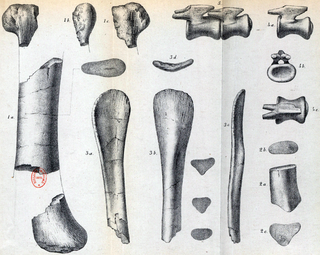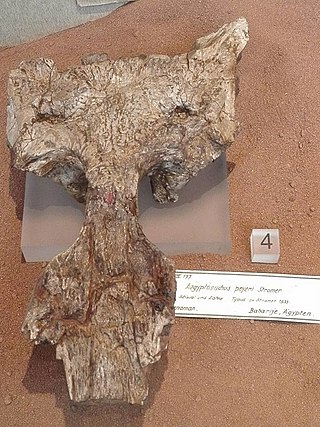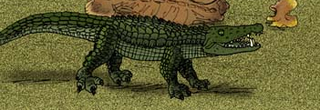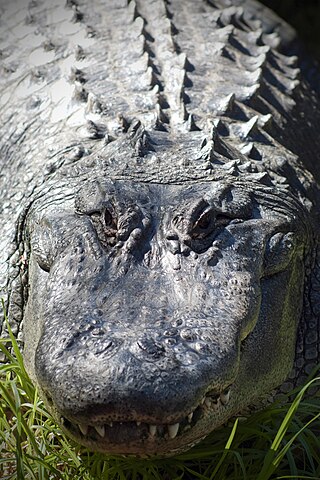
Rhabdodon is a genus of ornithopod dinosaur that lived in Europe approximately 70-66 million years ago in the Late Cretaceous. It is similar in build to a very robust "hypsilophodont", though all modern phylogenetic analyses find this to be an unnatural grouping, and Rhabdodon to be a basal member of Iguanodontia. It was large amongst its relatives, measuring 4 m (13 ft) long and weighing 250 kg (550 lb), with some specimens possibly reaching up to 6 m (20 ft) long.

Hypselosaurus is a dubious genus of titanosaurian sauropod that lived in southern France during the Late Cretaceous, approximately 70 million years ago in the early Maastrichtian. Hypselosaurus was first described in 1846, but was not formally named until 1869, when Phillip Matheron named it under the binomial Hypselosaurus priscus. The holotype specimen includes a partial hindlimb and a pair of caudal vertebrae, and two eggshell fragments were found alongside these bones. Because of the proximity of these eggshells to the fossil remains, many later authors, including Matheron and Paul Gervais, have assigned several eggs from the same region of France all to Hypselosaurus, although the variation and differences between these eggs suggest that they do not all belong to the same taxon. Hypselosaurus has been found in the same formation as the dromaeosaurids Variraptor and Pyroraptor, the ornithopod Rhabdodon, and the ankylosaurian Rhodanosaurus, as well as indeterminate bones from other groups.

Allodaposuchus is an extinct genus of crocodyliforms that lived in what is now southern Europe during the Campanian and Maastrichtian stages of the Late Cretaceous. Although generally classified as a non-crocodylian eusuchian crocodylomorph, it is sometimes placed as one of the earliest true crocodylians. Allodaposuchus is one of the most common Late Cretaceous crocodylomorphs from Europe, with fossils known from Romania, Spain, and France.

Boverisuchus is an extinct genus of planocraniid crocodyliforms known from the middle Eocene of Germany and western North America. It was a relatively small crocodyliform with an estimated total length of approximately 2.2–3.6 metres (7.2–11.8 ft).

Borealosuchus is an extinct genus of crocodyliforms that lived from the Late Cretaceous to the Eocene in North America. It was named by Christopher Brochu in 1997 for several species that had been assigned to Leidyosuchus. The species assigned to it are: B. sternbergii, the type species, from the Maastrichtian of Colorado, Montana, North Dakota, South Dakota, and Wyoming; B. acutidentatus, from the Paleocene of Saskatchewan; B. formidabilis, from the Paleocene of North Dakota; B. griffithi, from the Paleocene of Alberta; and B. wilsoni, from the Eocene of Wyoming. B. formidabilis is particularly well-known, represented by the remains of many individuals from the Wannagan Creek site in North Dakota.

Aegyptosuchus is an extinct monospecific genus of aegyptosuchid eusuchian crocodyliform. It was found in the Bahariya Formation of Egypt, which dates back to the Cenomanian age of the Late Cretaceous. The type and only species is Aegyptosuchus peyeri.

Eusuchia is a clade of neosuchian crocodylomorphs that first appeared in the Early Cretaceous, which includes modern crocodilians. Along with Dyrosauridae and Sebecosuchia, they were the only crocodyliformes who survived the K-Pg extinction.
The Arcillas de Morella Formation is a geological formation in Spain whose strata date back to the Barremian stage of the Early Cretaceous. Dinosaur remains are among the fossils that have been recovered from the formation.

Acynodon is an extinct genus of eusuchian crocodylomorph from the Late Cretaceous, with fossils found throughout Southern Europe.
Dolichochampsa is an extinct genus of eusuchian crocodylomorph. It is the type genus and only member of the family Dolichochampsidae. Fossils have been found in the Yacoraite Formation of Argentina and the El Molino Formation of Bolivia of Maastrichtian age. It had a distinctive slender snout. Because the material associated with the specimens is so fragmentary, its relationships with other eusuchians remain unknown. Jouve et al. (2020) assigned Dolichochampsa to Gavialoidea, making it the oldest known South American member of this clade.

Musturzabalsuchus is an extinct monospecific genus of allodaposuchid eusuchian crocodyliform. The type and only species is Musturzabalsuchus buffetauti.

Planocrania is an extinct genus of eusuchian crocodyliforms from what is now China. Two species are currently known to belong to the genus.

Gavialoidea is one of three superfamilies of crocodylians, the other two being Alligatoroidea and Crocodyloidea. Although many extinct species are known, only the gharial Gavialis gangeticus and the false gharial Tomistoma schlegelii are alive today, with Hanyusuchus having become extinct in the last few centuries.

Brevirostres is a paraphyletic group of crocodilians that included alligatoroids and crocodyloids. Brevirostres are crocodilians with small snouts, and are distinguished from the long-snouted gharials. It is defined phylogenetically as the last common ancestor of Alligator mississippiensis and Crocodylus niloticus and all of its descendants. This classification was based on morphological studies primarily focused on analyzing skeletal traits of living and extinct fossil species, and placed the gharials outside the group due to their unique skull structure, and can be shown in the simplified cladogram below:

Planocraniidae is an extinct family of eusuchian crocodyliforms known from the Paleogene of Asia, Europe and North America. The family was coined by Li in 1976, and contains three genera, Boverisuchus, Duerosuchus and Planocrania. Planocraniids were highly specialized crocodyliforms that were adapted to living on land. They had extensive body armor, long legs, and blunt claws resembling hooves, and are sometimes informally called "hoofed crocodiles".

Allodaposuchidae is an extinct clade of eusuchians that lived in Europe during the Late Cretaceous (Santonian-Maastrichtian).
Lohuecotitan is an extinct genus of titanosaurian sauropod dinosaur which lived during the Late Cretaceous in Spain. The only species known in the genus is Lohuecotitan pandafilandi, described and named in 2016.

Lohuecosuchus is an extinct genus of allodaposuchid eusuchian crocodylomorph that lived during the Late Cretaceous in what is now Spain and southern France.
Solemys is an extinct genus of stem turtle known from the Late Cretaceous of southern France and eastern Spain.

Agaresuchus is an extinct genus of allodaposuchid eusuchian crocodylomorph from the Late Cretaceous (Campanian-Maastrichtian) of Spain. It includes two species, the type species Agaresuchus fontisensis, and Agaresuchus subjuniperus, which was originally named as a species of the related genus Allodaposuchus. However, it has been proposed that both species may instead belong to the genus Allodaposuchus.


















